The Development of Agricultural Drought Monitoring and Drought Limit Water Level Assessments for Plateau Lakes in Central Yunnan Based on MODIS Remote Sensing: A Case Study of Qilu Lake
Abstract
1. Introduction
2. Research Area and Data
2.1. Overview of the Research Area
2.2. Data Sources
3. Research Methods
3.1. Vegetation Health Index
3.2. Determination Method for Drought Limit Water Levels
4. Results and Analysis
4.1. Subsection
4.2. Seasonal Variation Characteristics of VHI for Drought Assessment
4.2.1. Monthly Variability Characteristics of VHI
4.2.2. Seasonal Variation Characteristics of VHI
4.2.3. Interannual Variation Characteristics of VHI
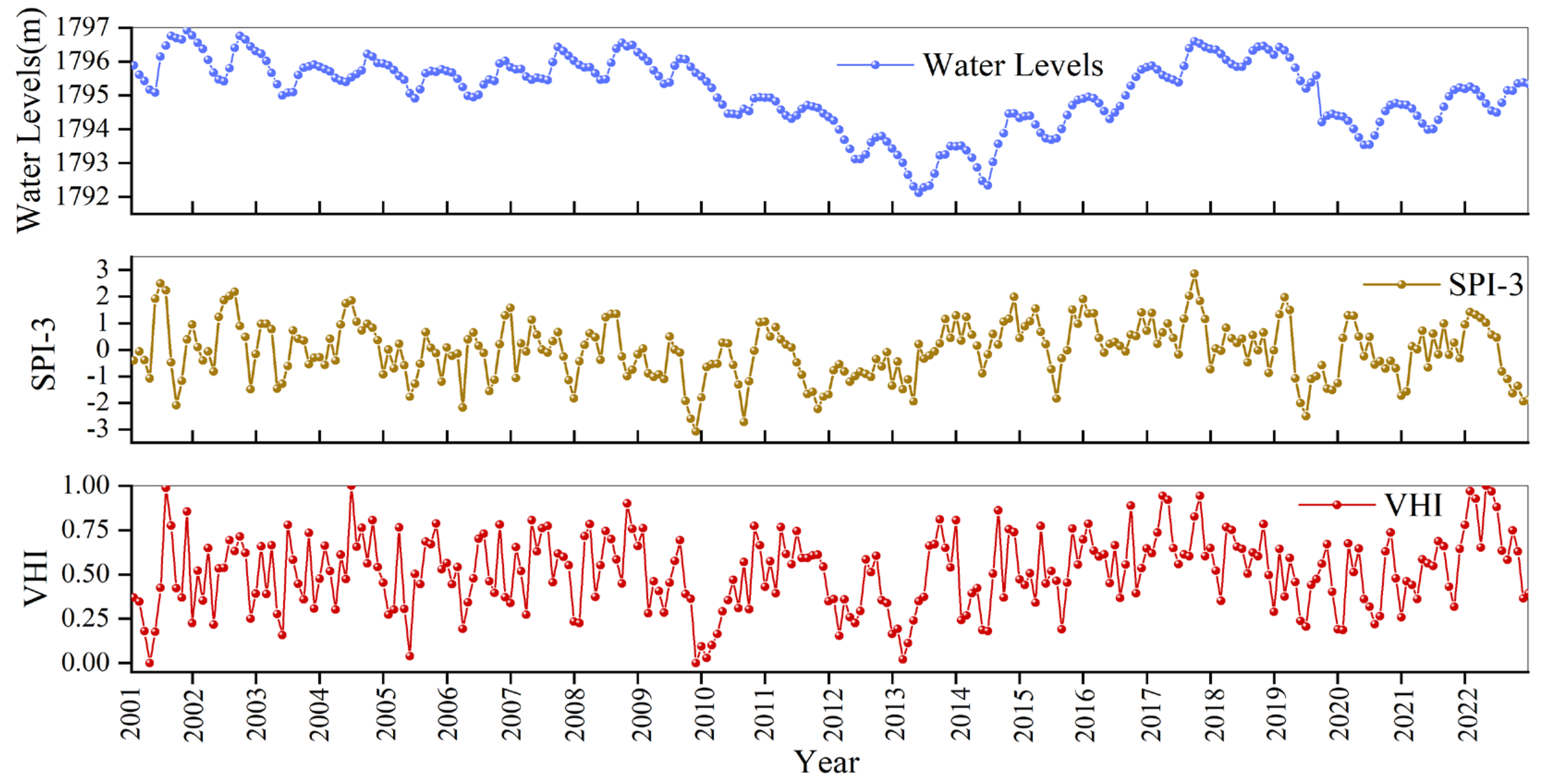
4.3. Calculation of Drought-Resistant Water Level Factors for the Lake
4.3.1. Determination of Ecological Water Level for Qilu Lake

4.3.2. External Water Demand for the Lake
4.3.3. Calculation of Inflow Runoff to the Lake
4.3.4. Calculation of Lake Surface Evaporation
4.4. Revision and Determination of Drought Limit Water Levels
4.5. Rationality Analysis of Drought Limit Water Levels
5. Conclusions
- Adaptation of VHI: By utilizing hydrometeorological data and satellite remote sensing information and allocating the VCI and TCI a weight ratio of 4:6, the VHI effectively reflected the variations in vegetation growth conditions and surface temperatures within the Qilu Lake watershed. Moreover, the correlation between the TCI and VHI was stronger than that between the VCI and the VHI. A comparison of the SPI at various scales revealed that the VHI demonstrated the best adaptability when associated with SPI-3.
- Seasonal Drought Patterns: Drought occurrences in the Qilu Lake watershed exhibit distinct seasonal characteristics; spring and winter experience higher frequencies, while summer and autumn experience lower frequencies, consequently reducing associated drought risks. In terms of interannual variations, the period from 2009 to 2012 displayed marked drought phenomena, with three of those years experiencing severe drought conditions. The intensity of agricultural drought peaked in 2009, while the duration of agricultural drought was the longest in 2012.
- In response to the situation after the occurrence of drought, a comprehensive analysis of the watershed’s hydrological conditions, variations in water usage, and agricultural drought was conducted. The drought limit water levels of Qilu Lake were categorized into long- and short-term conditions. The short-term drought limit water levels were further divided into drought warning water levels (corresponding to an inflow frequency of P = 75%), which ranged from 1794.53 m to 1795.11 m, and drought protection water levels (corresponding to an inflow frequency of P = 95%), which fell within the range of 1793.94 m to 1794.31 m. The long-term drought limit water levels were established by adding the water shortages from various sectors, which were caused by different intensities of agricultural drought, to the short-term drought limit water levels. This setting was designed to meet the emergency water supply needs for drought resistance within the watershed. Based on the water resource allocation rules within the watershed, the rationality of the drought limit water levels was examined. On this basis, water resource management strategies targeting lake water levels under different drought conditions were proposed to address the drought situation within the watershed.
Author Contributions
Funding
Institutional Review Board Statement
Informed Consent Statement
Data Availability Statement
Acknowledgments
Conflicts of Interest
References
- Christian, J.I.; Martin, E.R.; Basara, J.B.; Furtado, J.C.; Otkin, J.A.; Lowman, L.E.L.; Hunt, E.D.; Mishra, V.; Xiao, X. Global projections of flash drought show increased risk in a warming climate. Earth Environ. 2023, 4, 165. [Google Scholar] [CrossRef]
- Spinoni, J.; Naumann, G.; Vogt, J.V. Pan-European seasonal trends and recent changes of drought frequency and severity. Glob. Planet. Change 2017, 148, 113–130. [Google Scholar] [CrossRef]
- Osmani, S.A.; Baik, J.; Narimani, R.; Kim, J.-S.; Jun, C. Quantification of interactions among agricultural drought indices within Köppen–Geiger climate zones in Bangladesh. Agric. Water Manag. 2024, 302, 108952. [Google Scholar] [CrossRef]
- Qian, T.; Shi, Z.; Gu, S.; Xi, W.; Chen, J.; Chen, J.; Bai, S.; Wu, L. A Water Shortage Risk Assessment Model Based on Kernel Density Estimation and Copulas. Water 2024, 16, 1465. [Google Scholar] [CrossRef]
- Cook, B.I.; Mankin, J.S.; Marvel, K.; Williams, A.P.; Smerdonand, J.E.; Anchukaitis, K.J. Twenty-First Century Drought Projections in the CMIP6 Forcing Scenarios. Earth Future 2020, 8, e2019EF001461. [Google Scholar] [CrossRef]
- Dilling, L.; Daly, M.E.; Kenney, D.A.; Klein, R.; Miller, K.; Ray, A.J.; Travis, W.R.; Wilhelmi, O. Drought in urban water systems: Learning lessons for climate adaptive capacity. Clim. Risk Manag. 2019, 23, 32–42. [Google Scholar] [CrossRef]
- Lukk, A.K.; Lusardiand, R.A.; Willis, A.D. Water Management for Conservation and Ecosystem Function: Modeling the Prioritization of Source Water in a Working Landscape. J. Water Resour. Plan. Manag. 2023, 149, 5646. [Google Scholar] [CrossRef]
- Ziervogel, G.; Ericksen, P.J. Adapting to climate change to sustain food security. WIREs Clim. Chang. 2010, 1, 525–540. [Google Scholar] [CrossRef]
- Liu, Z.; Zhou, W.; Wang, X. Extreme Meteorological Drought Events over China (1951–2022): Migration Patterns, Diversity of Temperature Extremes, and Decadal Variations. Adv. Atmos. Sci. 2024, 41, 2313–2336. [Google Scholar] [CrossRef]
- Zhang, Q.; Zou, X.; Chen, X.; Zhao, L.; Li, T.; Qian, Z. A New Drought Index Study that Takes into Account a Multi-timescale and the Effects of Evapotranspiration—Taking Yunnan as an Example. Plateau Meteorol. 2022, 41, 909–920. [Google Scholar]
- Wu, Z.Y.; Lu, G.H.; Wen, L.; Lin, C.A. Reconstructing and analyzing China’s fifty-nine year (1951–2009) drought history using hydrological model simulation. Hydrol. Earth Syst. Sci. 2011, 15, 2881–2894. [Google Scholar] [CrossRef]
- Yu, M.; Li, Q.; Hayes, M.J.; Svoboda, M.D.; Heim, R.R. Are droughts becoming more frequent or severe in China based on the Standardized Precipitation Evapotranspiration Index: 1951–2010? Int. J. Climatol. 2013, 34, 545–558. [Google Scholar] [CrossRef]
- Wilhite, D.A.; Sivakumar, M.V.K.; Pulwarty, R. Managing drought risk in a changing climate: The role of national drought policy. Weather Clim. Extrem. 2014, 3, 4–13. [Google Scholar] [CrossRef]
- Chiang, F.; Mazdiyasni, O.; Aghakouchak, A. Evidence of anthropogenic impacts on global drought frequency, duration, and intensity. Nat. Commun. 2021, 12, 2754. [Google Scholar] [CrossRef]
- Fang, G.; Tu, Y.; Wen, X.; Yan, M.; Tan, Q. Study on the development process and evolution characteristics of meteorological drought in the Huaihe River Basin from 1961 to 2015. J. Hydraul. Eng. 2019, 20, 598–611. [Google Scholar]
- Mannocchi, F.; Todisco, F.; Vergni, L. Evaluating the uncertainty and reliability of standardized indices. Hydrol. Res. 2017, 48, 701–713. [Google Scholar]
- Wang, X.; Zhang, Y.; Feng, X.; Feng, Y.; Xue, Y.; Pan, N. Analysis and application of drought characteristics based on run theory and Copula function. Trans. Chin. Soc. Agric. Eng. 2017, 33, 206–214. [Google Scholar]
- Laimighofer, J.; Laaha, G. How standard are standardized drought indices? Uncertainty components for the SPI & SPEI case. J. Hydrol. 2002, 613, 128385. [Google Scholar]
- Zhu, Y.; Liu, Y.; Ma, X.; Ren, L.; Singh, V.P. Drought Analysis in the Yellow River Basin Based on a Short-Scalar Palmer Drought Severity Index. Water 2018, 10, 1526. [Google Scholar] [CrossRef]
- Mirgol, B.; Nazari, M.; Etedali, H.R.; Zamanian, K. Past and future drought trends, duration, and frequency in the semi-arid Urmia Lake Basin under a changing climate. Meteorol. Appl. 2021, 28, e2009. [Google Scholar] [CrossRef]
- Spinoni, J.; Barbosa, P.; De Jager, A.; McCormick, N.; Naumann, G.; Vogt, J.V.; Magni, D.; Masante, D.; Mazzeschi, M. A new global database of meteorological drought events from 1951 to 2016. J. Hydrol. Reg. Stud. 2019, 22, 100593. [Google Scholar] [CrossRef] [PubMed]
- Li, J.; Wu, X.; Wang, Z.; Yin, J.; Chen, X. Changes of drought characteristics in future in Pearl River Basin describing by a new comprehensive standardized drought index. J. Hydraul. Eng. 2021, 52, 486–497. [Google Scholar]
- Rajsekhar, D.; Singh, V.P.; Mishra, A.K. Multivariate drought index: An information theory based approach for integrated drought assessment. J. Hydrol. 2015, 526, 164–182. [Google Scholar] [CrossRef]
- Shah, D.; Zhao, G.; Li, Y.; Singh, V.P.; Gao, H. Assessing global reservoir-based hydrological droughts by fusing storage and evaporation. Geophys. Res. Lett. 2024, 51, e2023GL106159. [Google Scholar] [CrossRef]
- Chen, J.; Sun, H.; Wang, J.; Liao, W.; Chen, H. Improvement of comprehensive meteorological drought index and its applicability analysis. Trans. Chin. Soc. Agric. Eng. 2020, 32, 71–77. [Google Scholar]
- Chang, J.; Li, Y.; Wang, Y.; Yuan, M. Copula-based drought risk assessment combined with an integrated index in the Wei River Basin, China. J. Hydrol. 2016, 540, 824–834. [Google Scholar] [CrossRef]
- Seiler, R.A.; Hayes, M.; Bressan, L. Using the standardized precipitation index for flood risk monitoring. Int. J. Climatol. 2022, 22, 1365–1376. [Google Scholar] [CrossRef]
- Leng, J.; Ma, K.; Gu, S.; Zhang, K.; He, D. A non-stationary impactquant framework for assessing the human activity impacts on hydrological drought in the Upper Red River. Atmos. Res. 2024, 304, 107419. [Google Scholar] [CrossRef]
- Yang, N.; Deng, S. Research Progress in Agricultural Drought Monitoring Based on Multi-source Information. J. Catastrophol. 2024, 39, 125–135. [Google Scholar]
- Wen, W.; Timmermans, J.; Chen, Q.; van Bodegom, P.M. Evaluating crop-specific responses to salinity and drought stress from remote sensing. Int. J. Appl. Earth Obs. Geoinf. 2023, 122, 103438. [Google Scholar] [CrossRef]
- Xu, Y.; Wang, L.; Ross, K.W.; Liu, C.; Berry, K. Standardized Soil Moisture Index for Drought Monitoring Based on SMAP Observations and 36 Years of NLDAS Data: A Case Study in the Southeast United States. Remote Sens. 2018, 10, 301. [Google Scholar] [CrossRef] [PubMed]
- Martínez-Fernández, J.; González-Zamora, A.; Sánchez, N.; Gumuzzio, A. A soil water based index as a suitable agricultural drought indicator. J. Hydrol. 2015, 522, 265–273. [Google Scholar] [CrossRef]
- Zhou, L.; Wu, J.; Zhang, J.; Leng, S.; Liu, M.; Zhang, J.; Zhao, L.; Zhang, F.; Shi, Y. The Integrated Surface Drought Index (ISDI) as an Indicator for Agricultural Drought Monitoring: Theory, Validation, and Application in Mid-Eastern China. IEEE J. Sel. Top. Appl. Earth Obs. Remote Sens. 2013, 6, 1254–1262. [Google Scholar] [CrossRef]
- Lv, X.R.; Yin, X.T.; Gong, A.D.; Wang, Q.F.; Li, J.; Zhang, H. Temporal and spatial analysis of agricultural drought in yunnan province based on vegetation condition Index. J. Geo-Inf. Sci. 2016, 18, 1634–1644. [Google Scholar] [CrossRef]
- Fontana, F.M.A.; Coops, N.C.; Khlopenkov, K.V.; Trishchenko, A.P.; Riffler, M.; Wulder, M.A. Generation of a novel 1km NDVI data set over Canada, the northern United States, and Greenland based on historical AVHRR data. Remote Sens. Environ. 2012, 121, 171–185. [Google Scholar] [CrossRef]
- Li, C.; Adu, B.; Wu, J.; Qin, G.; Li, H.; Han, Y. Spatial and temporal variations of drought in Sichuan Province from 2001 to 2020 based on modified temperature vegetation dryness index (TVDI). Ecol. Indic. 2022, 139, 108883. [Google Scholar] [CrossRef]
- Bokusheva, R.; Kogan, F.; Vitkovskaya, I.; Conradt, S.; Batyrbayeva, M. Satellite-based vegetation health indices as a criteria for insuring against drought-related yield losses. Agric. For. Meteorol. 2016, 220, 200–206. [Google Scholar] [CrossRef]
- Rhee, J.; Im, J.; Carbone, G.J. Monitoring agricultural drought for arid and humid regions using multi-sensor remote sensing data. Remote Sens. Environ. 2010, 114, 2875–2887. [Google Scholar] [CrossRef]
- Xia, J.; Chen, J.; She, D. Impacts and countermeasures of extreme drought in the Yangtze River Basin in 2022. J. Hydraul. Eng. 2022, 53, 1143–1153. [Google Scholar]
- Dorsey, J.H. Improving water quality through California’s Clean Beach Initiative: An assessment of 17 projects. Environ. Monit. Assess. 2009, 166, 95–111. [Google Scholar] [CrossRef]
- Fang, D.; Fath, B.D.; Chen, B.; Scharler, U.M. Network environ analysis for socio-economic water system. Ecol. Indic. 2014, 47, 80–88. [Google Scholar] [CrossRef]
- Guo, S.; Liu, P.; Wang, J.; Zhou, Y. Revisiting necessity and feasibility for dynamic control of reservoir water level during flood season. J. Hydraul. Eng. 2023, 54, 1–12. [Google Scholar]
- Candido, L.A.; Coêlho, G.A.G.; de Moraes, M.M.G.A.; Florêncio, L. Review of Decision Support Systems and Allocation Models for Integrated Water Resources Management Focusing on Joint Water Quantity-Quality. J. Water Resour. Plan. Manag. 2022, 148, 03121001. [Google Scholar] [CrossRef]
- Chen, J.; Yang, X.; Dao, H.; Gu, H.; Chen, G.; Mao, C.; Bai, S.; Gu, S.; Zhou, Z.; Yan, Z. Analyses on Characteristics of Spatial Distribution and Matching of the Human–Land–Water–Heat System on the Yunnan Plateau. Water 2024, 16, 867. [Google Scholar] [CrossRef]
- Yong, Z.; Hao, W.; Hao, M.; Guohua, H.; Fan, H. Conception of China’s Double T-shaped water network economic pattern construction. J. Hydraul. Eng. 2022, 53, 1271–1279+1290. [Google Scholar]
- Chen, J.; Guo, S.; Li, Y.; Liu, P.; Zhou, Y. Joint Operation and Dynamic Control of Flood Limiting Water Levels for Cascade Reservoirs. Water Resour. Manag. 2013, 27, 749–763. [Google Scholar] [CrossRef]
- Luo, C.; Ding, W.; Zhang, F.; Yan, D.; Yan, Z.; Zhou, H. Research on the design and control of grading and staged drought-limited water level for reservoir. J. Hydraul. Eng. 2022, 53, 348–357. [Google Scholar]
- Zhou, J.; Lu, Z.; Lou, S.; Huang, W.; Xiao, W.; Wu, H. A method for determining and dynamic controlling the limit water level of lakes by classification and stages. J. Hydraul. Eng. 2022, 53, 127–138. [Google Scholar]
- Ge, Q.; Gu, S.; Wang, L.; Chen, G.; Chen, J. Optimal Determination and Dynamic Control Analysis of the Graded and Staged Drought Limit Water Level of Typical Plateau Lakes. Water 2023, 15, 2580. [Google Scholar] [CrossRef]
- Nanjing Institute of Geography & Limnology, Chinese Academy of Sciences. Research Report of Chinese Lakes; Science Press: Beijing, China, 2019. [Google Scholar]
- Zhang, T.; Wang, F.; Yang, X.; Ma, P.; Gu, S.; Bai, S.; Li, Y. Identification and remediation countermeasures of the Agriculture water problem in Qilu lake basin. IOP Conf. Ser. Earth Environ. Sci. 2019, 376, 012063. [Google Scholar] [CrossRef]
- Chen, J.; Zhang, T.; Gu, S. Study on Encounter of Runoff Abundance and Scarcity BetweenSource Area and Receiving Area of the Central YunnanIrrigation Project and the Hydrological Drought. Water Resour. Power 2024, 42, 23–27. [Google Scholar]
- Bento, V.A.; Gouveia, C.M.; DaCamara, C.C.; Libonati, R.; Trigo, I.F. The roles of NDVI and Land Surface Temperature when using the Vegetation Health Index over dry regions. Glob. Planet. Chang. 2020, 190, 103198. [Google Scholar] [CrossRef]
- Zeng, J.; Zhang, R.; Qu, Y.; Bento, V.A.; Zhou, T.; Lin, Y.; Wu, X.; Qi, J.; Shui, W.; Wang, Q. Improving the drought monitoring capability of VHI at the global scale via ensemble indices for various vegetation types from 2001 to 2018. Weather. Clim. Extrem. 2022, 35, 100412. [Google Scholar] [CrossRef]
- Gui, L.; Jiang, X.; Chen, J.; Yu, P.; Gu, S.; Chen, Y.; Chen, Y. Shoreline delimited and management of Qilu lake based on the river (lake) chief system. China Rural Water Hydropower 2022, 6, 8–15. [Google Scholar]

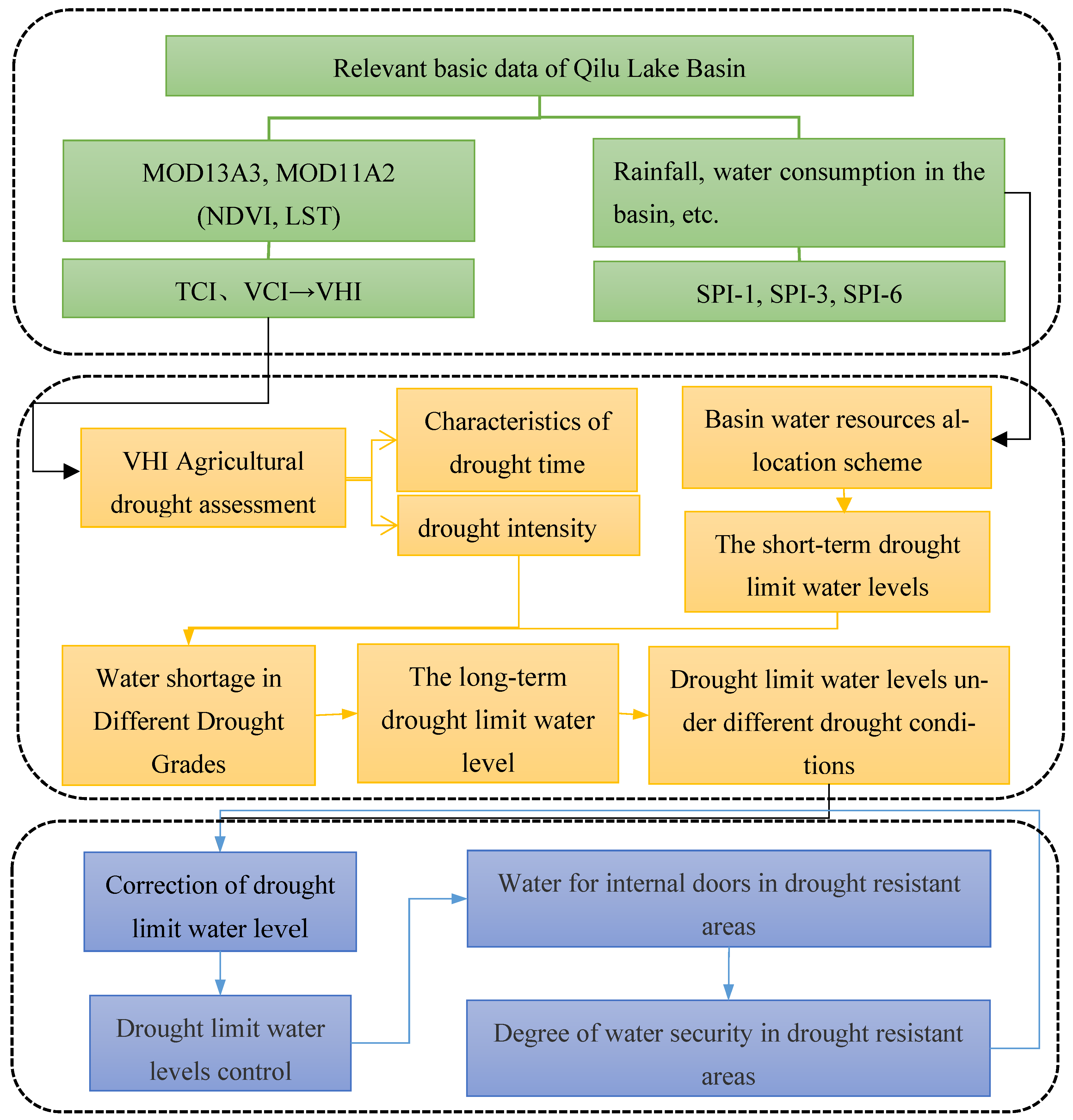
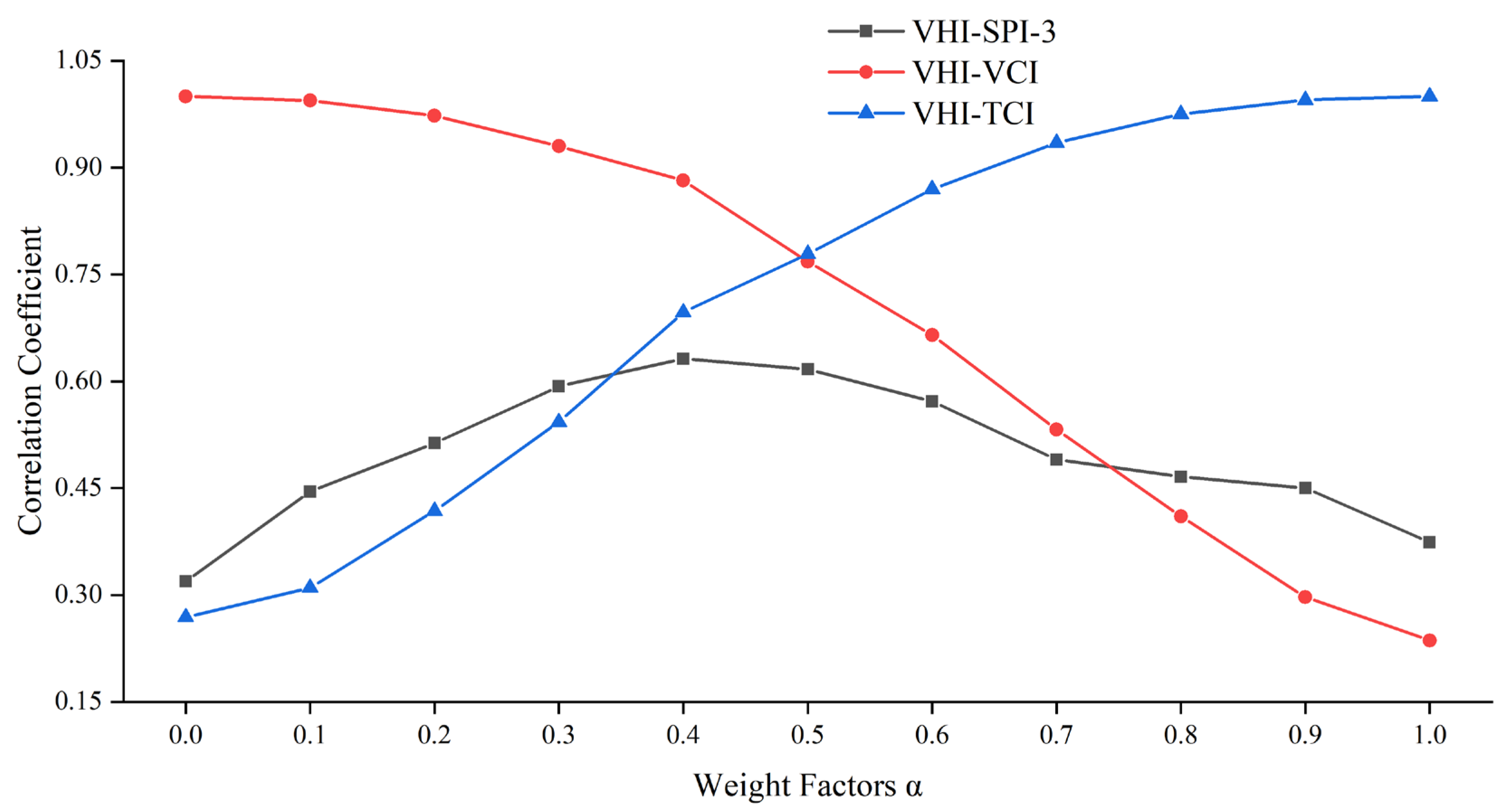
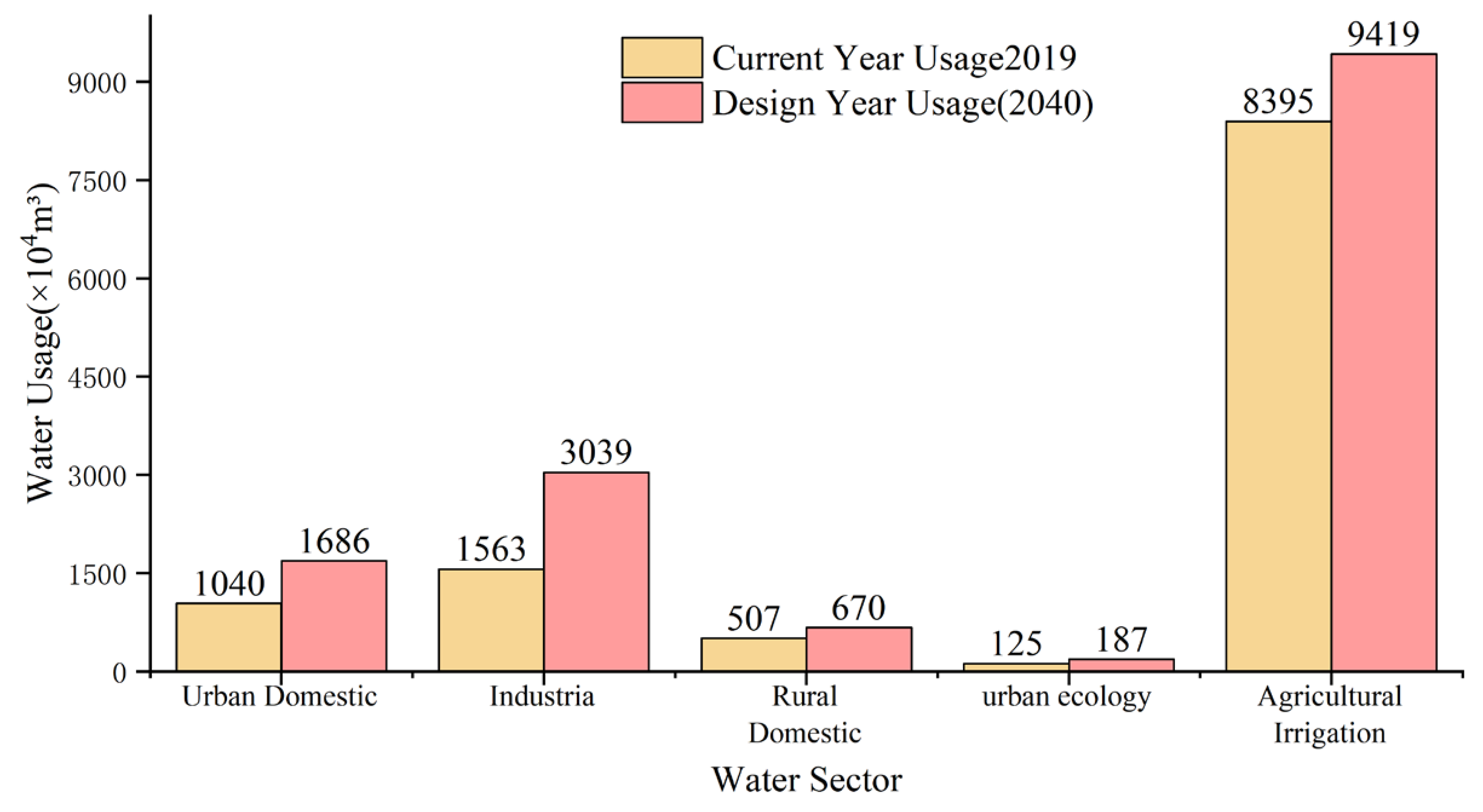
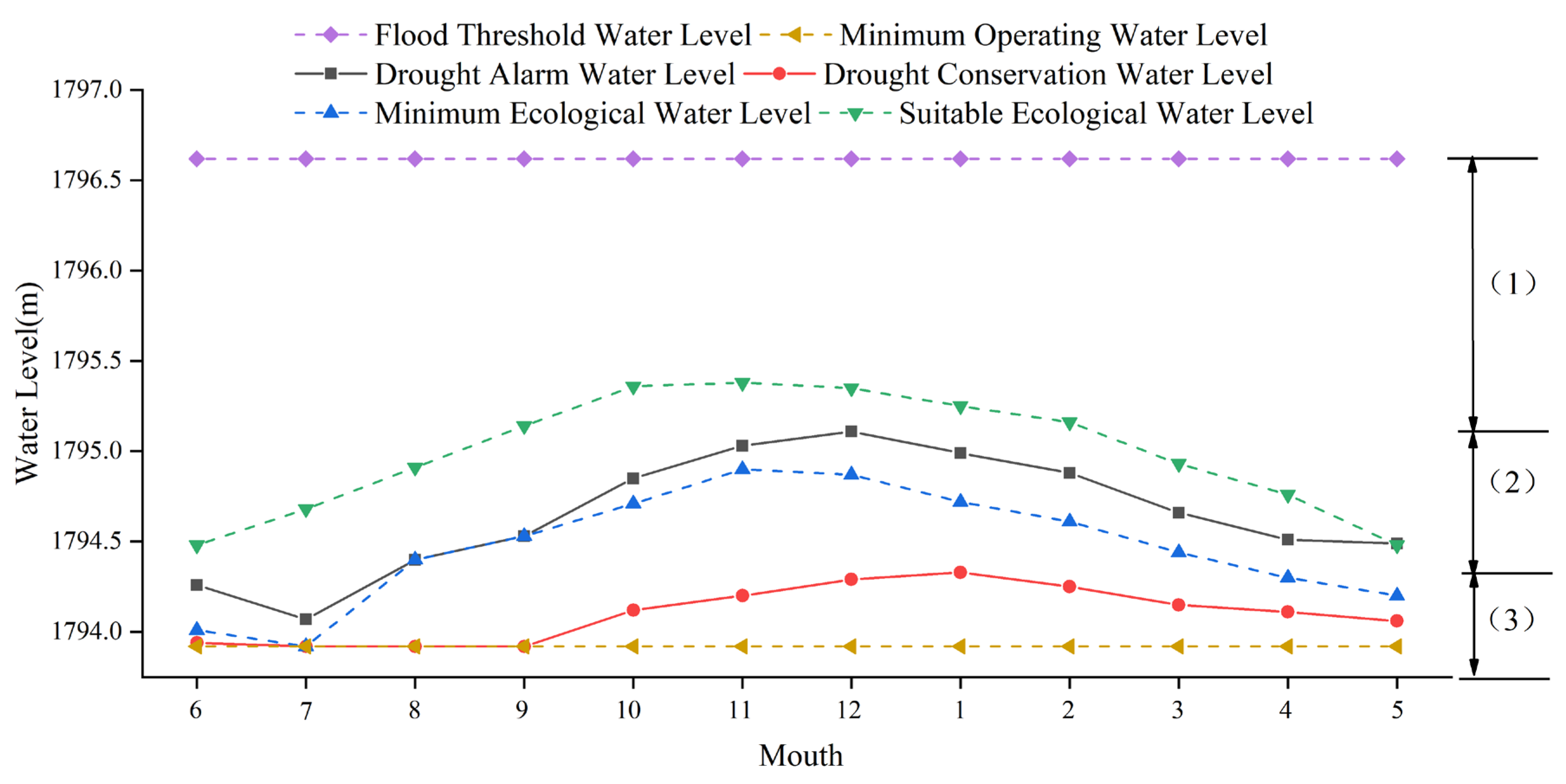

| Category | SPI | VHI | Precipitation (mm/mouth) |
|---|---|---|---|
| Wet | ≥−0.5 | ≥0.4 | ≥43.4 |
| Mild drought | −1~−0.5 | 0.3~0.4 | 26.7~43.4 |
| Moderate drought | −1.5~−1 | 0.2~0.3 | 15.7~27.6 |
| Severe drought | −2~−1.5 | 0.1~0.2 | 7.54~15.7 |
| Extreme drought | <−2 | <0.1 | <7.5 |
| Month | January | February | March | April | May | June |
|---|---|---|---|---|---|---|
| Drought Alarm Water Level (P = 75%) | 1794.99 | 1794.88 | 1794.66 | 1794.51 | 1794.29 | 1794.06 |
| Drought Conservation Water Level (P = 95%) | 1794.33 | 1794.25 | 1794.15 | 1794.11 | 1794.06 | 1793.94 |
| Month | July | August | September | October | November | December |
| Drought Alarm Water Level (P = 75%) | 1793.97 | 1794.40 | 1794.53 | 1794.85 | 1795.03 | 1795.11 |
| Drought Conservation Water Level (P = 95%) | 1793.92 | 1793.92 | 1793.92 | 1794.12 | 1794.20 | 1794.29 |
| Urban Domestic | Industrial | Ecological Water Use | Agricultural Irrigation | |
|---|---|---|---|---|
| Drought Alarm Water Level (Lower Supply Limit) | 1 | 1 | 1 | 0.8 |
| Drought Conservation Water Level (Upper Supply Limit) | 0.9 | 0.8 | 0.75 | 0.5 |
Disclaimer/Publisher’s Note: The statements, opinions and data contained in all publications are solely those of the individual author(s) and contributor(s) and not of MDPI and/or the editor(s). MDPI and/or the editor(s) disclaim responsibility for any injury to people or property resulting from any ideas, methods, instructions or products referred to in the content. |
© 2025 by the authors. Licensee MDPI, Basel, Switzerland. This article is an open access article distributed under the terms and conditions of the Creative Commons Attribution (CC BY) license (https://creativecommons.org/licenses/by/4.0/).
Share and Cite
Gu, S.; Gao, K.; Zhou, Y.; Chen, J.; Chen, J.; Ou, J. The Development of Agricultural Drought Monitoring and Drought Limit Water Level Assessments for Plateau Lakes in Central Yunnan Based on MODIS Remote Sensing: A Case Study of Qilu Lake. Sustainability 2025, 17, 4662. https://doi.org/10.3390/su17104662
Gu S, Gao K, Zhou Y, Chen J, Chen J, Ou J. The Development of Agricultural Drought Monitoring and Drought Limit Water Level Assessments for Plateau Lakes in Central Yunnan Based on MODIS Remote Sensing: A Case Study of Qilu Lake. Sustainability. 2025; 17(10):4662. https://doi.org/10.3390/su17104662
Chicago/Turabian StyleGu, Shixiang, Kai Gao, Yanchen Zhou, Jinming Chen, Jing Chen, and Jie Ou. 2025. "The Development of Agricultural Drought Monitoring and Drought Limit Water Level Assessments for Plateau Lakes in Central Yunnan Based on MODIS Remote Sensing: A Case Study of Qilu Lake" Sustainability 17, no. 10: 4662. https://doi.org/10.3390/su17104662
APA StyleGu, S., Gao, K., Zhou, Y., Chen, J., Chen, J., & Ou, J. (2025). The Development of Agricultural Drought Monitoring and Drought Limit Water Level Assessments for Plateau Lakes in Central Yunnan Based on MODIS Remote Sensing: A Case Study of Qilu Lake. Sustainability, 17(10), 4662. https://doi.org/10.3390/su17104662





